
| Part of a series on the |
| Culture of Turkey |
|---|
 |
| Languages |
| Mythology and Folklore |
| Cuisine |
| Festivals |
| Religion |
| Art |
| Literature |
Architecture of Turkey or Turkish architecture in the republican period is the architecture practised in Turkey since the foundation of the republic in 1923. In the first years of the republic, Turkish architecture was influenced by Seljuk and Ottoman architecture, in particular during the First National Architectural Movement (also called the Turkish Neoclassical architecture movement). However, starting from the 1930s, architectural styles began to differ from traditional architecture, also as a result of an increasing number of foreign architects being invited to work in the country, mostly from Germany and Austria.[1] The Second World War was a period of isolation, during which the Second National Architectural Movement emerged. Similar to Fascist architecture, the movement aimed to create a modern but nationalistic architecture.[2]
From the 1950s the nation became more internationally connected, which enabled Turkish architects to experiment with new styles and become increasingly inspired by their counterparts in the rest of the world. However, they were largely constrained by the lack of technological infrastructure or insufficient financial resources until the 1980s.[3] Thereafter, the liberalization of the economy and the shift towards export-led growth[4] paved the way for the private sector to become the leading influence on architecture in Turkey.
1920s to early 1930s: First national architectural movement
The First National Architectural Movement (Turkish: Birinci Ulusal Mimarlık Akımı) was an architectural movement led by Turkish architects Vedat Tek (1873–1942) and Mimar Kemaleddin Bey (1870–1927). Followers of the movement wanted to create a new and "national" architecture, which was based on motifs from Seljuk and Ottoman architecture. The movement was also labelled Turkish Neoclassical architecture, or the National Architectural Renaissance.[5] Other prominent followers of this movement were Arif Hikmet Koyunoğlu (1888–1982) and Giulio Mongeri (1873–1953).[6] Notable buildings from this era are the Istanbul Main Post Office (1905–1909), Tayyare Apartments (1919–1922),[7] Istanbul 4th Vakıf Han (1911–1926),[8] State Art and Sculpture Museum (1927–1930),[9] Ethnography Museum of Ankara (1925–1928),[10] Bebek Mosque,[11] and Kamer Hatun Mosque.[12][13]
Italian architect Raimondo D'Aronco served as the chief palace architect to the Ottoman Sultan Abdülhamid II in Istanbul for 16 years. D'Aronco designed and built a large number of buildings of various types in Istanbul. The stylistic features of his works can be classified in three groups: Revivalism, reinterpretation of the Ottoman forms, Art Nouveau and Vienna Secession. Art Nouveau was first introduced to Istanbul by D'Aronco, and his designs reveal that he drew freely on Byzantine and Ottoman decorations. D'Aronco also mixed Western and Oriental styles in his work, which was likewise a notable characteristic of the designs of Alexander Vallaury in the same period.[14]

 Istanbul Main Post Office interior
Istanbul Main Post Office interior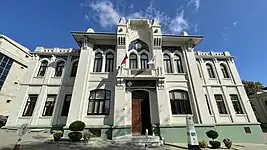 Old Fatih Municipality Building built by Yervant Terziyan
Old Fatih Municipality Building built by Yervant Terziyan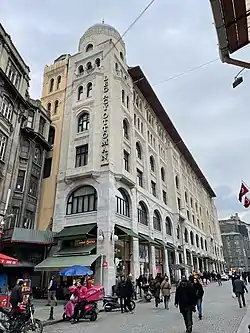

_the_Building_of_Ziraat_Bankas%C4%B1_(Agricultural_Bank)%252C_1930s_(16851406391).jpg.webp) First Ziraat Bank Headquarters in Ankara
First Ziraat Bank Headquarters in Ankara

 Ethnography Museum of Ankara was designed by architect Arif Hikmet Koyunoğlu (1925-1928).
Ethnography Museum of Ankara was designed by architect Arif Hikmet Koyunoğlu (1925-1928). Ankara Palas Hotel
Ankara Palas Hotel Denizli Gazi Mustafa Kemal Elementary School (1932)
Denizli Gazi Mustafa Kemal Elementary School (1932)
1930s to 1950s: Modernism and foreign influence
The Bauhaus style Florya Atatürk Marine Mansion (1935) and the Art Deco style Ankara Central Station (1937) are among the notable examples of this era.[15][16] As there were not enough architects in Turkey until the 1950s, various architects were invited by the government from Germany, Austria, Switzerland and France, in order to manage the rapid construction of the new capital Ankara. About 40 architects and urban planners designed and oversaw various projects (mostly in Ankara, and to a lesser extent in Istanbul and Izmir) between 1924 and 1942. Among them were Gudrun Baudisch, Rudolf Belling, Paul Bonatz, Ernst Arnold Egli, Martin Elsaesser, Anton Hanak, Franz Hillinger, Clemens Holzmeister, Henri Prost, Paolo Vietti-Violi, Werner Issel, Hermann Jansen, Theodor Jost, Heinrich Krippel, Carl Christoph Lörcher, Robert Oerley, Bernhard Pfau, Bruno Taut and Josef Thorak.[1][2]
Selected examples of buildings from this era are the Bauhaus style Florya Atatürk Marine Mansion (1935) designed by Seyfi Arkan; the Art Deco style Ankara railway station (1937) designed by Şekip Akalın; the Court of Cassation building (1933–35) designed by Clemens Holzmeister; the Faculty of Languages, History and Geography building (1937) of Ankara University designed by Bruno Taut; and the Grand National Assembly of Turkey building (1938–63) designed by Clemens Holzmeister.[15]
 Designed by Seyfi Arkan, Florya Atatürk Marine Mansion (1935) is a notable Bauhaus style building in Istanbul.
Designed by Seyfi Arkan, Florya Atatürk Marine Mansion (1935) is a notable Bauhaus style building in Istanbul.%252C_1934_(16826593236).jpg.webp)
.jpg.webp)
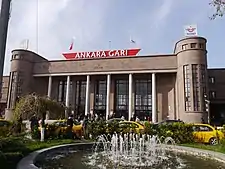
.jpg.webp) The Faculty of Languages, History and Geography building (1937) of Ankara University
The Faculty of Languages, History and Geography building (1937) of Ankara University The Faculty of Languages, History and Geography building (1937) of Ankara University was designed by Bruno Taut.
The Faculty of Languages, History and Geography building (1937) of Ankara University was designed by Bruno Taut.
Second national architectural movement
The Stripped Classicism movement of the late 1930s and early 1940s in Europe and North America sought a modern interpretation of Neoclassical architecture. The movement had a particularly notable impact on Fascist architecture in Italy and Nazi architecture in Germany, which aimed to develop the modern versions of the architecture of the Roman (Italy) and Holy Roman (Germany) empires, according to their ideologies. In the same period, there was a trend towards creating a new national architecture in Turkey, which was called the Second National Architectural Movement (Turkish: İkinci Ulusal Mimarlık Akımı).[2][17][18] The foreign architects employed in Turkey in this period (especially from Germany and Austria) played an important role in the introduction of this architectural movement and its style. The pioneers of the movement in Turkey were Sedad Hakkı Eldem, Ekrem Hakkı Ayverdi[19] and Emin Halid Onat. To lead this movement, Professor Sedad Hakkı Eldem held National Architecture seminars at Mimar Sinan Fine Arts University, focusing on traditional Turkish house styles.[20]
Like their contemporary equivalents in Europe and North America, the government buildings of this style in Ankara and Istanbul typically had large proportions (high ceilings, high windows, etc.) to give the impression of a strong state authority. Some of them also had monumental facade designs reminiscent of Neoclassical architecture; but with more modern and plain rectangular shapes, symmetry, simplicity, and a general lack of ornateness.
Some of the buildings in this style are the Ankara Opera House, designed by Şevki Balmumcu (1933–34) and renovated by Paul Bonatz (1946–47); the TCDD General Headquarters Building designed by Bedri Uçar in 1938; Istanbul University Faculty of Science and Faculty of Literature buildings (1944–52); Anıtkabir (1944–53); Istanbul Radio Headquarters (1945–49); Şişli Mosque (1945–49); and the Çanakkale Martyrs' Memorial (1954–60). The movement was particularly influential between 1935 and 1950. From the 1950s, the influence of this style diminished due to the next wave, especially International Style and Rationalism.[20]
 The Faculty of Law building (1937) of Ankara University.
The Faculty of Law building (1937) of Ankara University. The Grand National Assembly of Turkey building (1938–63) in Ankara was designed by Clemens Holzmeister.
The Grand National Assembly of Turkey building (1938–63) in Ankara was designed by Clemens Holzmeister.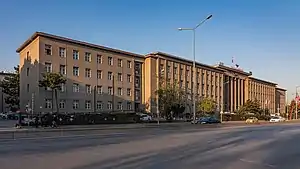 TCDD General Headquarters Building, designed by Bedri Uçar (1939–41).
TCDD General Headquarters Building, designed by Bedri Uçar (1939–41).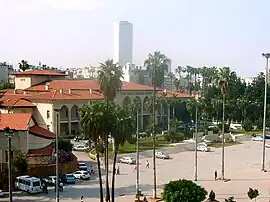
 Istanbul University Faculty of Science and Faculty of Literature Buildings, designed by Sedad Hakkı Eldem and Emin Halid Onat (1944–52).
Istanbul University Faculty of Science and Faculty of Literature Buildings, designed by Sedad Hakkı Eldem and Emin Halid Onat (1944–52). Istanbul University Faculty of Science and Faculty of Literature Buildings
Istanbul University Faculty of Science and Faculty of Literature Buildings


1950s and more Western influence
At the beginning of the 1950s, a new generation of architects such as Nevzat Erol, Turgut Cansever, Abdurrahman Hancı, Cengiz Bektaş, Hayati Tabanlıoğlu, Enver Tokay, İlhan Tayman and Yılmaz Sanlı became more influential in the architectural arena. These were architects who either studied in Europe or had information of the modernist architecture of the time. Their quest for modernist architecture was in line with the International Style and Rationalism. However, the development of the Turkish economy was an important factor as well. Even though Turkish architects were able to follow up on the modern design of important architects of the time, they were constrained by the lack of technological infrastructure or insufficient financial resources.[3][13]
Selected examples of buildings from this era are the Anadolu Club Hotel (1951–1957) in Büyükada designed by Turgut Cansever and Abdurrahman Hancı; Hilton Istanbul Bosphorus (1952–1955) designed by Skidmore, Owings & Merrill and Sedad Hakkı Eldem; Istanbul Municipality Headquarters (1953–1960) designed by Nevzat Erol; Emek Business Center (1959–1965) in Ankara designed by Enver Tokay and İlhan Tayman; and Tekel Headquarters (1958–1960) in Istanbul designed by Yılmaz Sanlı and İlhan Tayman.[3]
One of the most important developments of this period was the establishment of the Chamber of Architects of Turkey in 1954. Various professional organizations for architects had existed beforehand, but there were no laws for the architectural profession until 1954.[21] Brutalist architecture become popular during 1950s, the work of Behruz Çinici in Middle East Technical University is the best example of this era.


 Istanbul Metropolitan Municipality City Hall was designed in 1953 by Nevzat Erol.
Istanbul Metropolitan Municipality City Hall was designed in 1953 by Nevzat Erol. InterContinental Hotel, formerly Sheraton Istanbul, was designed in 1959 by AHE and Rolf Gutbrod.
InterContinental Hotel, formerly Sheraton Istanbul, was designed in 1959 by AHE and Rolf Gutbrod..jpg.webp) Middle East Technical University Rectorate Building
Middle East Technical University Rectorate Building Middle East Technical University Pedestrian Way
Middle East Technical University Pedestrian Way Middle East Technical University Library
Middle East Technical University Library Middle East Technical University Library
Middle East Technical University Library.jpg.webp) Middle East Technical University Faculty of Architecture
Middle East Technical University Faculty of Architecture.jpg.webp) Middle East Technical University Rectorate Building
Middle East Technical University Rectorate Building Middle East Technical University Faculty of Architecture
Middle East Technical University Faculty of Architecture.jpg.webp) Middle East Technical University Faculty of Architecture
Middle East Technical University Faculty of Architecture.jpg.webp) Middle East Technical University Faculty of Architecture
Middle East Technical University Faculty of Architecture.jpg.webp) Rıza Derviş House, also known as Derviş Manizade Mansion, built 1956–1957, is one of two buildings designed by Sedad Hakkı Eldem that was realized on Büyükada
Rıza Derviş House, also known as Derviş Manizade Mansion, built 1956–1957, is one of two buildings designed by Sedad Hakkı Eldem that was realized on Büyükada.jpg.webp) Rıza Derviş House. Architect, Sedad Hakkı Eldem was inspired by modernist architecture, which is evident not only in the architecture of the house, but also in the simplicity of the garden and its furniture
Rıza Derviş House. Architect, Sedad Hakkı Eldem was inspired by modernist architecture, which is evident not only in the architecture of the house, but also in the simplicity of the garden and its furniture.jpg.webp) Rıza Derviş House is considered an experimental project in rationalism, a trend that became popular after World War II
Rıza Derviş House is considered an experimental project in rationalism, a trend that became popular after World War II.jpg.webp) Rıza Derviş House built in 1956-1957
Rıza Derviş House built in 1956-1957.jpg.webp) Rıza Derviş House built in 1956-1957
Rıza Derviş House built in 1956-1957.jpg.webp) Rıza Derviş House built in 1956-1957
Rıza Derviş House built in 1956-1957.jpg.webp) Rıza Derviş House built in 1956-1957
Rıza Derviş House built in 1956-1957
1960s and 1970s
Following the 1960 coup d'état, Turkey endured various kinds of political and economic crises which affected the construction industry as well as the architectural sector. Despite these hardships, architects were able to design some important buildings. Abandoning Rationalism, Turkish architects tried to design their buildings in more flexible and fragmented forms. Important works from this period are the Vakıflar Hotel in Istanbul (1968, today the Ceylan Intercontinental Hotel), Middle East Technical University Campuses (1961) in Ankara, Istanbul Manufacturers' Market (1959), Turkish Historical Society Building (1967), Grand Ankara Hotel (1960, today the Rixos Grand Ankara Hotel) and Atatürk Cultural Center (1969) in Istanbul.[22][23]
As a result of economic and social turbulence, architecture in Turkey suffered also in the 1970s. There were no significant breakthroughs during this period. Some important designs from the 1970s are the Turkish Language Association Building (1972), Atatürk Library (1973) and Abdi İpekçi Arena (1979).[24]
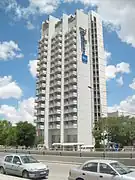 Radisson Blu Hotel in Ankara, originally built as Stad Oteli (1970), was designed in 1964 by Doğan Tekeli, Sami Sisa and Metin Hepgüler.
Radisson Blu Hotel in Ankara, originally built as Stad Oteli (1970), was designed in 1964 by Doğan Tekeli, Sami Sisa and Metin Hepgüler.
.jpg.webp) The Bosphorus Bridge (1973) in Istanbul was designed in 1968–1970 by Gilbert Roberts and William Brown.
The Bosphorus Bridge (1973) in Istanbul was designed in 1968–1970 by Gilbert Roberts and William Brown. The Marmara Hotel (1976) at Taksim Square was designed in 1972 by Fatin Uran.
The Marmara Hotel (1976) at Taksim Square was designed in 1972 by Fatin Uran. BDDK Building (1975) in Ankara, originally the Türkiye İş Bankası headquarters, designed by Ayhan Böke and Yılmaz Sargın.
BDDK Building (1975) in Ankara, originally the Türkiye İş Bankası headquarters, designed by Ayhan Böke and Yılmaz Sargın.
1980s and 1990s
In January 1980, the government of Prime Minister Süleyman Demirel began implementing a far-reaching reform program designed by then Undersecretary of the Prime Ministry Turgut Özal to shift Turkey's economy toward export-led growth. These reforms had a positive effect on the construction industry and architecture.[4] New methods such as prefabrication and curtain wall systems were introduced to Turkish architects and contractors in the 1980s. In addition, steel, aluminum, plastic and glass production increased, which allowed architects to free themselves from rigid forms.

Until the 1980s, the government sector was the leading client when it came to architecture and construction. However, the liberalization of the economy paved the way for the private sector to become the leading influence. Notable architects from this period include Behruz Çinici, Merih Karaaslan, Sevinç Hadi, Şandor Hadi, Ersen Gürsel, Mehmet Çubuk, Doğan Tekeli, Sami Sisa, Emre Arolat, Murat Tabanlıoğlu, Melkan Tabanlıoğlu, Hüsrev Tayla, Doğan Hasol, Atilla Yücel, Sema Soygeniş, Murat Soygeniş and Kaya Arıkoğlu, among others.[23][24][25]
21st century
When architects and structural engineers collaborate they can design buildings which are more sustainable.[28]
Earthquakes
In earthquake-prone areas, all buildings built to 20th century standards may be dangerous,[29] but shortly after the 1999 İzmit earthquake, which killed over 17 thousand people, a new seismic code was brought into force to protect against earthquakes in Turkey.[30][31] Also following that earthquake a so-called earthquake tax was raised during the government of Bülent Ecevit.[32] Initially thought as a temporary tax, it became permanent.[30] In 2007 the seismic code was strengthened.[33][34] However, it is alleged that builders often ignored the rules due to corruption.[35] After the 2011 Van earthquakes Prime Minister Recep Tayyip Erdoğan said: "Municipalities, constructors and supervisors should now see that their negligence amounts to murder."[36] In 2018, a zoning law gave amnesties to some unlicensed buildings and some with unlicensed floors.[36]
Further resilience over the 2007 code was mandated in the 2018 Turkish Seismic Code, which took effect on 1 January 2019.[33][37] Improvements included design supervision and site specific hazard definitions,[38] and for new buildings in vulnerable regions required rebar in high quality concrete.[39] Beams and columns in those buildings must be in the right place to properly absorb shaking.[39] The code is said by foreign experts to be very modern and similar to US codes.[40] However, these 21st century building codes were not very well enforced.[29]
In a bid to shore up support going into the 2018 Turkish presidential election, the government offered amnesties for violations of the building code, allowing non-compliance to continue with the payment of a fee.[41] This poor enforcement of seismic codes was a contributing factor to the devastation of the 2023 Turkey–Syria earthquakes in which over 42,000 people died in Turkey.[31] There were high incidences of support column failure leading to pancake collapses, which complicated rescue efforts. Experts lamented the practice would turn cities into graveyards.[42] The 2023 Turkey–Syria earthquakes collapsed many older buildings and some recent ones:[43] the Environment and Urbanization Ministry is assessing the damage.[44]
Unreinforced masonry buildings are vulnerable.[45] Many older buildings in Istanbul are vulnerable to pancake collapses.[46] Retrofitting old buildings is possible but expensive.[46] Although over 3 million housing units nationwide were strengthened in the 2 decades before 2023, as of that year many apartment blocks do not meet 21st century standards.[43] Building with wood has been suggested.[47]
Climate change
Buildings in Turkey are the largest energy consumers, and there are substantial opportunities for energy savings in both new build and renovations.[48] A typical residential building emits almost 50 kgCO2eq/m2/year, mostly due to the energy used by residents.[49] The Organisation for Economic Co-operation and Development (OECD) has said that more could be done to improve the energy efficiency of buildings, and that tax incentives offered for this would create jobs.[50]: 62 Turkey was a co-leader of the group discussing zero-carbon buildings at the 2019 UN Climate Action Summit, and the city of Eskişehir has pledged to convert all existing buildings to zero emissions by 2050.[51][52] Such energy efficiency improvements can be made in the same programme as increasing resilience to earthquakes in Turkey.[53] However, in 2020 gas was subsidized.[54]: 18 Increasing the proportion of passive houses has been suggested,[55] as has adopting some EU building standards.[56]
In rural areas without a piped gas supply, heat pumps could be an alternative to wood, coal and bottled gas: but buying a heat pump is rare as it is very expensive for householders as there is no subsidy.[57]: 29 However, owners of larger properties such as shopping centres, schools and government buildings have shown more interest.[58]
Direct geothermal heating (not to be confused with heat pumps) installed capacity totaled 3.5 GW thermal (GWt) in 2020, with the potential for 60 GWt, but it is unclear how much is low-carbon.[59] According to a 2020 report commissioned by the environment ministry and the EBRD further research on Turkish geothermal is needed: specifically how to limit carbon dioxide venting to the atmosphere.[60]: 283, 284
There is no data on the carbon intensity of cement.[61]: 13 Emissions from cement production could be lessened by reducing its clinker content[62]—for example, by making Limestone Calcined Clay Cement, which is only half clinker. The second-largest reduction could be made by switching half the fuel from hard coal and petroleum coke (petcoke) to a mixture of rubber from waste tires, refuse-derived fuel and biomass.[63] Although the country has enough of these materials, most cement kilns (there are 54[64]: 156 ) use coal, petcoke or lignite as their primary energy source.[64]: 154 More cross-laminated timber could be used for building, instead of concrete.[65]
Further decarbonisation of cement production would depend heavily on carbon capture and storage (CCS).[66][67]: 109 Despite Turkey's earthquake risk, CCS may be technically feasible in a salt dome near Lake Tuz[68] or in Diyarbakır Province.[69] Thinktank Ember suggest that rooftop solar should be mandatory on new buildings, and say that installation on apartment block roofs is hindered by bureaucracy.[70]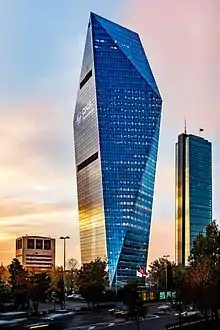 Finansbank Tower and Istanbul Sapphire on Büyükdere Avenue
Finansbank Tower and Istanbul Sapphire on Büyükdere Avenue
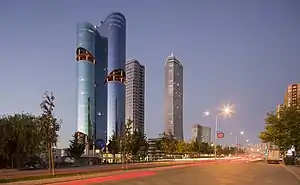 Avrupa Office in Ataşehir
Avrupa Office in Ataşehir

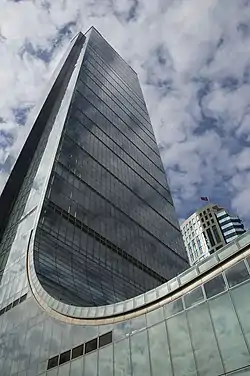
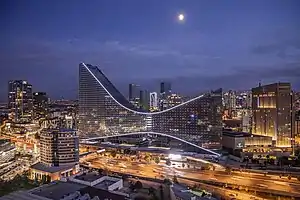 Skyline of Ankara
Skyline of Ankara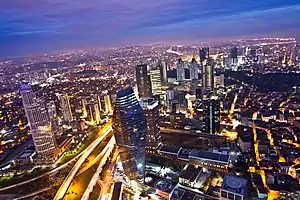 Skyline of Istanbul
Skyline of Istanbul Skyline of Bursa
Skyline of Bursa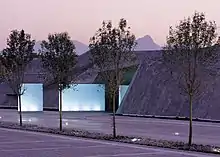 Minicity Theme Park, Antalya (2004)
Minicity Theme Park, Antalya (2004) Raif Dinçkök Yalova Cultural Center, Yalova (2011)
Raif Dinçkök Yalova Cultural Center, Yalova (2011) Maslak No.1 Office Building, Istanbul (2014)
Maslak No.1 Office Building, Istanbul (2014) Zorlu Center, Istanbul (2013)
Zorlu Center, Istanbul (2013)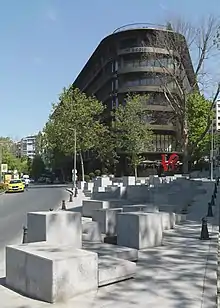 St.Regis Istanbul, Istanbul (2015)
St.Regis Istanbul, Istanbul (2015) Yalikavak Palmarina, Bodrum (2014)
Yalikavak Palmarina, Bodrum (2014) İzmir Adnan Menderes Airport
İzmir Adnan Menderes Airport Sakirin Mosque, The mosque's architect is believed to be the first woman to design a mosque. (2009)
Sakirin Mosque, The mosque's architect is believed to be the first woman to design a mosque. (2009) Ahmed Hamdi Akseki Mosque
Ahmed Hamdi Akseki Mosque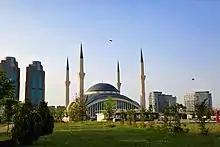 Ahmed Hamdi Akseki Mosque
Ahmed Hamdi Akseki Mosque Izmir Folkart Towers
Izmir Folkart Towers.jpg.webp)

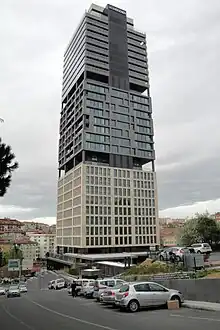 Le Méridien in Etiler, Istanbul
Le Méridien in Etiler, Istanbul
.jpg.webp) Yavuz Sultan Selim Bridge (2016)
Yavuz Sultan Selim Bridge (2016)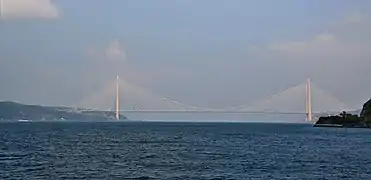 Yavuz Sultan Selim Bridge (2016)
Yavuz Sultan Selim Bridge (2016)
See also
Notes
- 1 2 "Deutschsprachige Architekten in der frühen Republik" (in German). Goethe Institut. Retrieved 20 January 2012.
- 1 2 3 "Michael Meeker. Review of Bozdogan, Sibel, Modernism and Nation Building: Turkish Architectural Culture in the Early Republic". H-Net Reviews, Humanities & Social Sciences Online. April 2003. Retrieved 2 February 2012.
- 1 2 3 "The 1950s and Modernism". ArchMuseum.org. Archived from the original on 13 September 2011. Retrieved 21 January 2012.
- 1 2 "Mapping Turkey, Short History of Architecture". www.culturalexchange-tr. Archived from the original on 11 December 2011. Retrieved 22 January 2012.
- ↑ "The Search for Identity: 1st National Architecture Movement". ArchMuseum.org. Archived from the original on 13 September 2011. Retrieved 20 January 2012.
- ↑ "Architecture of the '30s in Turkey". Dogan Hasol, Arhitext Magazine, June 2007. Archived from the original on 25 January 2014. Retrieved 20 January 2012.
- ↑ "Tayyare Apartment Building". AtelyeMim.com. Archived from the original on 17 June 2013. Retrieved 2 February 2012.
- ↑ "XIX. Yüzyış ve XX. Yüzyıl Başı Eminönü'nde Osmanlı Büro Hanları" (PDF) (in Turkish). Yıldız Teknik Üniversitesi-Fen Bilimleri Enstitüsü. Archived from the original (PDF) on 16 June 2012. Retrieved 27 February 2013.
- ↑ "Ankara - State Museum of Painting and Sculpture". Republic of Turkey, Ministry of Culture. Retrieved 2 February 2012.
- ↑ "Ankara - Ethnographical Museum". Republic of Turkey, Ministry of Culture. Retrieved 2 February 2012.
- ↑ "Bebek Mosque". ArchNet.org. Archived from the original on 3 January 2014. Retrieved 2 February 2012.
- ↑ "Kemer Hatun Mosque, Beyoglu, Istanbul" (in Turkish). MimarlikMuzesi.org. Archived from the original on 21 July 2012. Retrieved 2 February 2012.
- 1 2 "Mass Housing Development by a Government Agency and the Politics of Urbanization" (PDF). 14th International Planning History Conference submission by Nilufer Baturayoglu Yoney and Yildiz Salman, Istanbul Technical University Faculty of Architecture, Turkey. Retrieved 2 February 2012.
- ↑ Manfredi Nicoletti, Raimondo D'Aronco, Milano 1955.
- 1 2 Cengizkan, Ali (2010). "The production of a mise en scène for a nation and its subjects: Clemens Holzmeister et al. in the Ministries Quarter for Ankara, Turkey". The Journal of Architecture. 15 (6): 731–770. doi:10.1080/13602365.2011.533539. S2CID 144989288.
- ↑ "Florya Atatürk Marine Mansion". National Palaces of Turkey official web site. Archived from the original on 10 November 2011. Retrieved 2 February 2012.
- ↑ "Turkish Architectural Periodicals during the Republican Period, 1923-1980 by Ilker Ozdel at Dokuz Eylul University (Page 526)" (PDF). Çankaya University Journal of Humanities and Social Sciences, 7/2 (November 2010). Archived from the original (PDF) on 3 June 2013. Retrieved 5 February 2012.
- ↑ "The Ethos of Architects Towards an Analysis of Architectural Practice in Turkey, Thesis by Nilgun Fehim Kennedy, September 2005 (Page 23)" (PDF). Middle East Technical University, Turkey. Retrieved 5 February 2012.
- ↑ "Image of Ekrem Hakkı Ayverdi". dunyabizim.com. 25 April 2016. Retrieved 4 June 2023.
- 1 2 "A New Perspective on National Architecture: 2nd. National Architecture Movement". ArchMuseum.org. Archived from the original on 13 September 2011. Retrieved 21 January 2012.
- ↑ "Architectural Profession Around the World, Turkey". The International Union of Architects. Retrieved 21 January 2012.
- ↑ "1960's (Turkish Architecture in the Republican Period)". ArchMuseum.org. Archived from the original on 13 September 2011. Retrieved 22 January 2012.
- 1 2 Holod, Renata (January 2007). "Modern Turkish Architecture (Renata Holod)". Collections of Essays. Academia.edu (University of Pennsylvania. Retrieved 2 February 2012.
- 1 2 "1970's up to the Present (Turkish Architecture in the Republican Period)". ArchMuseum.org. Archived from the original on 13 September 2011. Retrieved 22 January 2012.
- ↑ "Women Architects". Ustun Alsac. Archived from the original on 21 February 2014. Retrieved 10 December 2013.
- ↑ "Istanbul's Unprecedented Property Boom Causes Concern About Citizens' Rights". Voice of America. Retrieved 2 February 2012.
- ↑ Albayrak, Ayla (11 January 2012). "New Tower to Dwarf Istanbul's Minarets". Wall Street Journal. Retrieved 2 February 2012.
- ↑ ÖZMEN, Cengiz; ÜNAY, Ali İhsan. "Architect – Structural Engineer Collaboration In Sustainable Structural System Design".
- 1 2 "In Turkey and Syria, outdated building methods all but assured disaster from a quake". NPR.
- 1 2 Baysan, Lauren Said-Moorhouse,Isil Sariyuce,Zeena Saifi,Reyhan (8 February 2023). "Emotions run high in Turkey amid questions over state response to deadly quake". CNN. Retrieved 11 February 2023.
{{cite web}}: CS1 maint: multiple names: authors list (link) - 1 2 "Turkey's earthquakes show the deadly extent of construction scams". The Economist. ISSN 0013-0613. Retrieved 13 February 2023.
- ↑ "Turkey quakes to cost nation $6.2 billion - Minister - Türkiye | ReliefWeb". reliefweb.int. Retrieved 11 February 2023.
- 1 2 "Turkey: New building code for earthquake resilience". www.preventionweb.net. Retrieved 6 February 2023.
- ↑ "2007 Turkish Earthquake Code" (PDF).
- ↑ "What made the earthquake in Turkey and Syria so deadly?". The Economist. ISSN 0013-0613. Retrieved 8 February 2023.
- 1 2 Beaumont, Peter (7 February 2023). "Turkey earthquake death toll prompts questions over building standards". The Guardian. ISSN 0261-3077. Retrieved 8 February 2023.
- ↑ "International-Workshop-on-Advanced-Materials-and-Innovative-Systems-in-Structural-Engineering-Seismic-Practices-New-Improvements-in-the-2018-Turkish-Seismic-Code".
- ↑ Sucuoğlu, Haluk. "New Improvements in the 2019 Building Earthquake Code of Turkey".
- 1 2 "Turkey earthquake: Anger at building standards grows". BBC News. 8 February 2023. Retrieved 8 February 2023.
- ↑ Pettersson, Lauren Said-Moorhouse,Christian Edwards,Krystina Shveda,Henrik (7 February 2023). "The earthquake in Turkey is one of the deadliest this century. Here's why". CNN. Retrieved 9 February 2023.
{{cite web}}: CS1 maint: multiple names: authors list (link) - ↑ "Turkey's lax policing of building codes known before quake". AP NEWS. 10 February 2023. Retrieved 12 February 2023.
- ↑ "Turkey earthquake failures leave Erdogan looking vulnerable". BBC News. 11 February 2023. Retrieved 12 February 2023.
- 1 2 "The earthquakes in Turkey and Syria have shaken both countries". The Economist. ISSN 0013-0613. Retrieved 10 February 2023.
- ↑ "Turkey earthquake: Anger at building standards grows". BBC News. 8 February 2023. Retrieved 9 February 2023.
- ↑ "Practices of Brick Masonry Construction in Turkey and their Seismic Behaviors during Earthquakes".
- 1 2 "Earthquake in Turkey a warning for Istanbul, which faces much larger death toll if quake strikes".
- ↑ "Hollanda'ya depreme dayanıklı konut yapmayı öğreten Türkiye neden bu kadar fazla yıkım yaşıyor?". BBC News Türkçe (in Turkish). 10 February 2023. Retrieved 13 February 2023.
- ↑ Ayas, Ceren (August 2020). Decarbonization of Turkey's economy: long-term strategies and immediate challenges (Report). Climate Action Network Europe, SEE Change Net, TEPAV. TR2015/DG/01/A5-02/147A.
- ↑ Atmaca, Adem; Atmaca, Nihat (15 March 2022). "Carbon footprint assessment of residential buildings, a review and a case study in Turkey". Journal of Cleaner Production. 340: 130691. doi:10.1016/j.jclepro.2022.130691. ISSN 0959-6526. S2CID 246561830.
- ↑ OECD Economic Surveys: Turkey 2021 (Report). OECD. 2021. ISSN 1999-0480.
- ↑ "12 global initiatives to beat back climate threats". Reuters. 23 September 2019. Archived from the original on 27 September 2019. Retrieved 27 September 2019.
- ↑ Renewables 2020 Global Status Report. REN21 (Report). p. 62. ISBN 978-3-948393-00-7. Archived from the original on 24 May 2019. Retrieved 30 September 2020.
- ↑ "World Bank Provides $265 million Boost to Improve Earthquake Resilience and Energy Efficiency of Public Buildings in Turkey". World Bank. Retrieved 10 June 2021.
- ↑ "Still Not Getting Energy Prices Right: A Global and Country Update of Fossil Fuel Subsidies". IMF. Retrieved 6 October 2021.
- ↑ "Sıfır Enerji ve Pasif Ev Derneği" [Zero energy and passive house association]. Sıfır Enerji ve Pasif Ev Derneği – SEPEV (in Turkish). Archived from the original on 3 December 2020. Retrieved 7 March 2021.
- ↑ Hatipoglu, Hatice Kalfaoglu; Cetin, Rukiye; Hatipoglu, Atilla (21 September 2022). "Sustainable housing: Analysis of energy performance potential in Turkey with translation of building standards of Austria". Građevinar (in Croatian). 74 (8): 647–659. doi:10.14256/JCE.3332.2021. ISSN 0350-2465. S2CID 252447067.
- ↑ "Turkey's Strategic Energy Efficiency Plan-an Ex Ante Impact Assessment of the Residential Sector". ResearchGate. Retrieved 25 August 2021.
- ↑ Cetin, Aysegul; Kadioglu, Yusuf Kagan; Paksoy, Halime (1 April 2020). "Underground thermal heat storage and ground source heat pump activities in Turkey". Solar Energy. 200: 22–28. Bibcode:2020SoEn..200...22C. doi:10.1016/j.solener.2018.12.055. ISSN 0038-092X. S2CID 127200801.
- ↑ "Turkey only outranked by China in direct utilization of geothermal energy". Think GeoEnergy – Geothermal Energy News. 4 April 2020. Archived from the original on 27 April 2020. Retrieved 29 April 2020.
- ↑ Stantec Mühendislik ve Müşavirlik Ltd.Şti (December 2020). Cumulative Impact Assessment of Geothermal Resources in Turkey. www.jeotermaletki.com (Report). Ministry of Environment and Urbanization of the Republic of Turkey and the European Bank for Reconstruction and Development.
- ↑ "Turkey 2020" (PDF). Climate Transparency.
- ↑ "Cement – Fuels & Technologies". International Energy Agency. Retrieved 23 August 2021.
- ↑ "Abstract on the potential GHG emissions reduction in Turkey through the cement industry" (PDF). Cementis GmbH. Archived (PDF) from the original on 21 March 2019. Retrieved 21 March 2019.
- 1 2 Turkish Greenhouse Gas Inventory 1990 - 2021 [TurkStat report]. Turkish Statistical Institute (Technical report). 14 April 2023.
- ↑ "Promoting Low Cost Energy Efficient Wooden Buildings in Turkey" (PDF). Global Environment Facility. Archived (PDF) from the original on 1 August 2020. Retrieved 15 September 2019.
- ↑ "Decarbonization of industrial sectors: the next frontier". McKinsey. Archived from the original on 28 July 2018. Retrieved 17 September 2018.
- ↑ Bill Gates (2021). How to Avoid a Climate Disaster. Penguin Random House.
- ↑ Glomazic, Rade; Raptsun, Mykola. "EU Carbon Capture and Storage Directive Preliminary Regulatory Impact Assessment (Pre-RIA)" (PDF). Archived (PDF) from the original on 30 April 2019. Retrieved 30 April 2019.
- ↑ Firtina Ertiş, İrem. "Application of Multi-criteria Decision Making for Geological Carbon Dioxide Storage Area in Turkey". Anadolu University Journal of Science and Technology A- Applied Sciences and Engineering. Archived from the original on 30 April 2019. Retrieved 17 June 2019.
- ↑ "Türkiye can expand solar by 120 GW through rooftops". Ember. 11 December 2023. Retrieved 28 December 2023.
- ↑ "Istanbul Sapphire". E-Architect.co.uk. 10 November 2011. Retrieved 2 February 2012.
References
- Holod, Renata (2005). Modern Turkish architecture. Ankara: Chamber of Architects of Turkey.
- Bozdoğan, Sibel (2002). Modernism and Nation Building: Turkish Architectural Culture in the Early Republic. University of Washington Press.
Further reading
- Sibel Bozdoğan and Esra Akcan, "Turkey: modern architectures in history", Reaktion Books, 2012.
